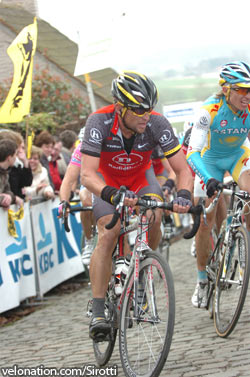Will the big Belgian’s omission leave the American team exposed when the race hits the stones?
 With the announcement of the RadioShack’s Tour de France team, one of the significant names missing is that of Gert Steegmans. The 29-year-old Belgian had his heart set on riding the Tour, and this comes as another blow to his already disappointing season. More than just his mixed results this year though, Steegmans’ non-selection also owes much to the exclusion of the RadioShack team from the Vuelta a España.
With the announcement of the RadioShack’s Tour de France team, one of the significant names missing is that of Gert Steegmans. The 29-year-old Belgian had his heart set on riding the Tour, and this comes as another blow to his already disappointing season. More than just his mixed results this year though, Steegmans’ non-selection also owes much to the exclusion of the RadioShack team from the Vuelta a España.
Without the Belgian’s experience the RadioShack team is possibly in danger of leaving itself exposed during the classics-style first week.
Steegmans rode last week’s Tour de Suisse in the service of Lance Armstrong and applied himself well. “We were happy with [his ride], but there are a number of elements working to his disadvantage,” said RadioShack director sportif Dirk Demol told Het Belang van Limburg.
“The fact that we are not invited to the Vuelta, we would have like to have had [Janez] Brajkovic to ride as the team leader,” he explained. “We can’t have the talented Slovenian riding no Grand Tours this year, so he rides the Tour. He is a lightning rod for [Lance] Armstrong.
“In addition,” Demol continued, “Armstrong showed in Switzerland that another victory is possible; we want domestiques both for the flat roads and climbs from the first day to the last summit.”
But will the big Belgian’s absence leave the team exposed as the Tour crosses the classics country and 13.2km of cobbles on stage 3? Along with the mountains and the long time trial, these much-feared roads, the terrain of the Paris-Roubaix, have been identified as potentially some of the most decisive kilometres in the race.
Defending champion Alberto Contador (Astana) took the opportunity to do some cobbled reconnaissance with 2003 Paris-Roubiax winner Peter Van Petegem in the spring. Armstrong himself rode the Ronde van Vlaanderen in order to get some cobbled kilometres in his legs before the Tour, and is taking the stage very seriously, just as he did in 2004.
“I think it’s an interesting course. It starts in an exciting way,” the American said after the Tour’s route was announced last October. “The first few days will provide a lot of drama for people between the crosswinds in Holland and the hills in and around Brussels and Spa. Of course, so too with the cobblestones when we first come into France. The cobbles themselves are dangerous but what is even more dangerous is the approach to them; the kilometres before, the nerves, the anticipation before, the positioning. That is the most dangerous part.
 Last time the Tour crossed the northern cobbles was in 2004 on the stage between Waterloo and Wasquehal. Back then Armstrong had the expert company of Paris-Roubaix specialists George Hincapie and Viatcheslav Ekimov; both of whom were regularly in the results at the cobbled classics; both of whom have finished on the podium at Paris-Roubaix.
Last time the Tour crossed the northern cobbles was in 2004 on the stage between Waterloo and Wasquehal. Back then Armstrong had the expert company of Paris-Roubaix specialists George Hincapie and Viatcheslav Ekimov; both of whom were regularly in the results at the cobbled classics; both of whom have finished on the podium at Paris-Roubaix.
“You need obviously a well-rounded team,” Armstrong added, “but I think you have to take some big guys who can definitely support you in that first week because with the cobble sections you have to be in the front. I remember we did those sections in 2004 and I had great support from Ekimov and Hincapie. We came in the cobble zones first. It makes a big difference.”
Even without Steegmans RadioShack still has the team to guide Armstrong through though, says Demol. “Gert was the ideal rider to pilot Lance across the cobblestones,” he conceded, “but [Yaroslav] Popovych has the same capabilities; and [Grégory] Rast and [Dmitriy] Muravyev also know their way around the cobblestones.”
Experienced Popovych, Rast and Muravyev may be, but neither knows the front of the cobbled classics like Steegmans does; Armstrong may find that his team is not what it was in 2004 when the race hits the infamous pavé du Nord.
Armstrong himself has no fear of the stones though, and may take it upon himself to lead the way, as he did in 2004.
Demol does give a clue to another reason why Steegmans has been left at home though: the fact that he may have held personal ambitions at the race.
“We chose pure domestiques,” he said, “you have to be realistic. We couldn’t expect Gert to ride completely in service of Armstrong; that would be against his nature. That couldn’t happen, Gert deserves better.”
In all of Armstrong’s years of dominance, it was very rare that a teammate was ever allowed to ride for anything more than an Armstrong victory. In those seven years the only stage winner on Armstrong’s team were his good friend Hincapie and Italian Paolo Savoldelli in 2005. Victory Hugo Peña wore the yellow jersey briefly in 2003, but he took it after the team time trial, and it was so he could wear it on his birthday. Even so, the Columbian still spent his time in yellow fetching bottles from the team car, much to the distaste of many traditionalists.
The idea that Steegmans may have been looking for his own stage victories, either in sprints or breakaways, would not have fitted the tried and tested all-for-one tactic that worked for all those years.